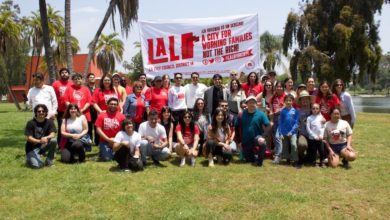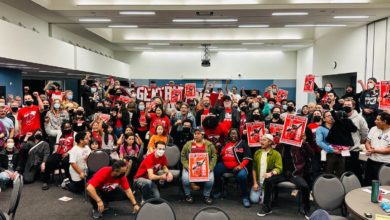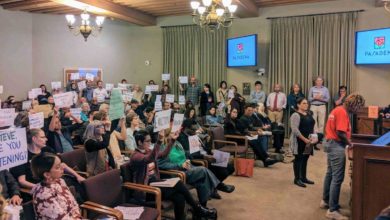Planters filled with succulents and cacti, sidewalk art installations, narrow benches with armrests. These decorative accents are seen in cities across the United States, but we should not be fooled by their ornamental facade. They’re examples of a phenomenon known as “hostile architecture” – the component pieces of our built environment carefully designed to ward off unwanted occupants – and, according to emails obtained through the California Public Records Act, part of a calculated effort by the City of Los Angeles and its ruling class to further displace people experiencing homelessness. According to the latest 2019 homeless count in Los Angeles County, this population now consists of over 50,000 people.
Although houseless people face hostility and humiliation anywhere they are forced to stay, Los Angeles has doubled down on its campaign of hostility in the wake of a homelessness crisis that has reached epidemic proportions. In a disturbing chain of emails published by MichaelKohlhaas.org, a blog by investigative journalists exposing local treatment of the homeless population, city officials and local business owners brainstormed ways to ways to drive out residents without permanent shelter.
“Is there an update on how we can stop the encampment being provided with fresh, untouched food?” asked Rebecca Vasak of JAHZ Properties. After a long email chain and several closed door meetings with law enforcement representatives, the group agreed to collectively cover sidewalks with unauthorized planters and community art under the guise of “beautification,” forcing people experiencing homelessness to move their tents elsewhere.
Adrian Riskin, a writer for MichaelKohlhass.org, spoke to Liberation News about the war being waged on houseless Angelenos. Riskin explained that although the creation of hostile environments is a tactic with a long history in LA, the problem goes much deeper than illegal sidewalk planters. “An environment can be made hostile towards the homeless by privatizing it,” he said. Special Enforcement Zones, for example, are areas in which the LAPD practices what Riskin describes as “hyper-enforcement of anti-homeless laws,” ostensibly in protection of the needs of local businesses.
Nowhere is the influence of private interest on public space more aggressive than in Hollywood’s Business Improvement District, where private security guards – collectively funded by local businesses – collaborate with the LAPD to arrest houseless people at rates unseen in the rest of the city. Although fewer than 300 residents experiencing homelessness live within the district at any given time, the number of arrests made by BID patrols exceeded 1,000 per year in recent years.
That number has dropped (largely due to scrutiny from MichaelKohlhaas.org, according to public records), but the criminalization of homelessness continues in the Hollywood BID and beyond. According to the Bureau of Labor Statistics, private security employees outnumber LAPD officers in the Los Angeles area by over seven to one, comprising unaccountable private armies mobilized by the rich to defend their property.
Los Angeles City Council has passed a multitude of laws that are unmistakably meant to punish unsheltered people. Sitting or lying on the sidewalk is prohibited, and “bulky items” can’t be stored on the sidewalk (except tents, but they must be taken down between the hours of 6 am-9 pm). Urinating in public is illegal, even if there are no public restrooms nearby. The LA City Council additionally voted recently to extend harsh restrictions on sleeping in cars – restrictions which activists say are tantamount to a ban. Although these ordinances can also affect people with reliable shelter, Riskin says the discretionary basis on which the LAPD and BID security guards enforce them show clearly that their primary purpose is to push people experiencing homelessness out of areas where powerful people don’t want them to be visible.
As senior LAPD officer Eddie Guerra said in the email chain about sidewalk planters: “We are in the displacement business.” Business, clearly, is booming. Los Angeles was home to an estimated 52,765 houseless people in 2018 – including roughly 5,000 children, 4,000 veterans, 5,000 elderly people, and 3,000 people fleeing domestic violence. Over 25 percent of Angelenos experiencing homelessness have a serious mental illness, and another 15 percent battles a substance use disorder. Even though LA Mayor Eric Garcetti anticipates a “double-digit increase” this year, the city’s response to the crisis continues to be ineffectual at best, with unfulfilled promises to build fifteen temporary shelters that would house a tiny fraction of those who need shelter.
The failure to support the tens of thousands of Angelenos experiencing homelessness isn’t, as Garcetti claims, due to a lack of resources – in Los Angeles, an economic hub of the most prosperous state in the country, the failure is due entirely to a lack of political will. Studies show that providing permanent supportive housing for those who are chronically houseless actually saves money. The only reason we lack the resources to sufficiently address homelessness is because those resources are being boarded and used elsewhere–such as the construction of a $2.2 billion luxury office building for city employees.
It would be foolish to expect local government to solve the crisis in any meaningful way, because the “displacement business” is an excellent investment. The wealthy elite need to blame homelessness on those experiencing it. Surely their circumstances are the result of poor decisions, laziness, some fundamental flaw in their very being. We need to keep them off the sidewalks–in fact, get them out of the city. We don’t want to look at them.
And here lies the crux of the matter. If people experiencing homelessness weren’t made invisible, we would be forced to confront the crisis directly – and that would mean confronting the system that not only allows homelessness to exist, but necessarily preserves its existence.
Under capitalism, our basic necessities – food, housing, healthcare, work – aren’t guaranteed. Edible food is destroyed to artificially inflate prices while children go hungry. National homelessness statistics tell us that an estimated 553,000 people sleep in the streets each night, while nearly 6 million housing units sit vacant. The exorbitant price of healthcare causes people to die of preventable illnesses every day.
Anyone taking a cursory look at the immense wealth that already exists in this country will see that we have more than what is to needed to fulfill the material needs of society. With a rationally planned socialist economy, we can harness our full productive capacity to guarantee housing, food, healthcare, and employment to every person in the United States. This is the task ahead of the U.S. working class–we must organize and fight, because changing the streets of the United States can change the streets of the world.





